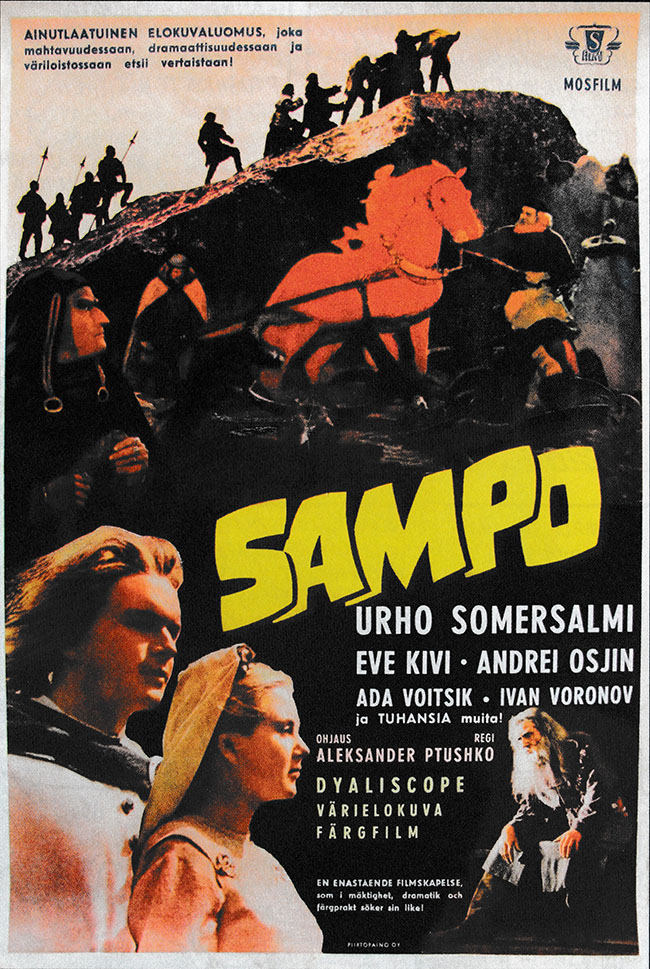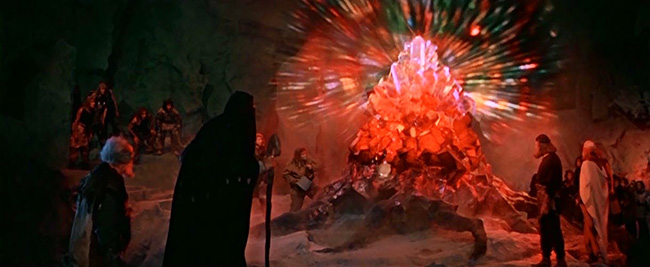
Longtime readers of this website (are there such things?) may recall that I have reviewed several Soviet-made fairy tale films in the past. Well, hoist your shields, lift your swords to the air, and invoke the firebird, because we’re about to dive into a whole new batch. To start off we’re going to look at some Russian (Mosfilm) and Russian-Finnish (Mosfilm/Suomi-Filmi) productions made famous stateside by their inclusion in Mystery Science Theater 3000 – appropriate, I think, to welcome the return of the cult TV show as new episodes will soon be airing on Netflix, produced by series creator Joel Hodgson. Remember Joel intoning the word “Sampo” with awe on the mid-90’s episode The Day the Earth Froze? In fact Sampo is the original title of the 1959 film, before it was dubbed and re-edited to silly mush, the version that Joel and the Bots riffed. “TV’s Frank” Conniff reflected in his 2016 book Twenty Five Mystery Science Theater 3000 Films That Changed My Life in No Way Whatsoever: “I kind of love this movie…There’s a lot of weird, goofy, surrealistic stuff in The Day the Earth Froze that might have appealed to me had I happened upon it in the middle of the night while stoned out of my mind…I was still struck by this film’s somber, hallucinatory charm. It might have even been too good for MST3K, but that could just be all the pot I smoked in the 1970’s talking.” Actually, it’s impressive how much of the unique quality of Sampo holds up even when silhouettes at the bottom of the screen are poking fun at it nonstop (and wondering endlessly what a “Sampo” is). In 2013 the film underwent a 4K restoration, and it was subsequently released on a Finnish DVD. The difference is striking. With its rich colors, compositions that bring to mind Maxfield Parrish and Frank Frazetta, and, yes, “somber, hallucinatory charm,” it becomes obvious that the film is altogether remarkable.
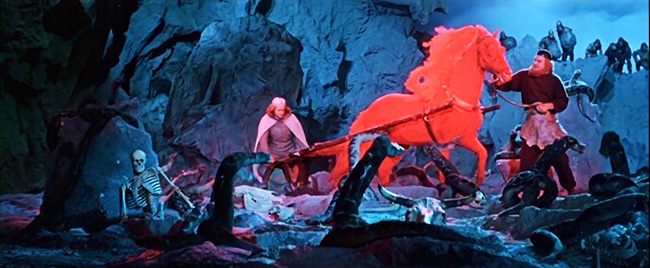
Lemminkäinen (Andris Ošiņš) plows a field of vipers with the aid of the blacksmith Ilmarinen (Ivan Voronov) and his horse forged in fire.
The film was directed by Aleksandr Ptushko, a Soviet Walt Disney who started in animation and came to specialize in elaborate, special effects-driven fantasy spectacles. Among his ambitious films are The New Gulliver (1935), Sadko (1952, absurdly rebranded in America as The Magic Voyage of Sinbad), Ilya Muromets (1956, which became The Sword and the Dragon), The Tale of Tsar Saltan (1967), and my personal favorite, the visually stunning Pushkin adaptation Ruslan and Ludmila (1972); Ptushko also contributed to the chilling horror fable Viy (1967). Really, it’s a compliment to the director that some of his films found there way to the U.S. at all, given that, by the time they reached our shores, it was the height of the Cold War. Not that the distributor, Roger and Gene Corman’s Filmgroup (calling this “A Renaissance Films Release”), played up the Russian connection. The press materials emphasized its Finnish roots without mentioning the Soviet Union at all, and many names were Americanized: lead actor Andris Ošiņš was now “Jon Powers,” and Ptushko became the mysterious “Gregg Sebelious.” Still, it’s easy to see why the Cormans decided to acquire the film. Sampo has much higher production values than anything to come out of the Corman factory: it has a cast of hundreds, ingenious special effects, and even some first-class log-riding.
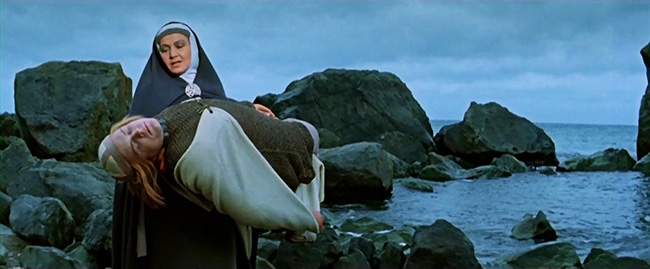
Lemminkäinen’s mother (Ada Vojtsik) mourns his drowning.
So what is a Sampo? It’s a machine of sorts, a mill which must be magically forged and assembled with “the lid in many colors” before it begins spontaneously generating gold coins, salt, and grain (your basic necessities, really). It’s also the central MacGuffin of the epic poem Kalevala as retold by 19th century philologist Elias Lönnrot, a compiler of oral storytelling. At the start of the film, we’re treated to a neat little sequence: a statue depicts Lönnrot standing beside an ancient Finnish storyteller; then the two figures come to life, the old man plucking the strings of his kantele and singing the tale of Kalevala, while Lönnrot begins to transcribe. Our blond-tressed hero, Lemminkäinen (Ošiņš), learns that his lover, Annikki (Eve Kivi, Ruslan and Ludmila), has been abducted by the witch Louhi (Anna Orochko). Louhi accomplishes this with a handy trick: she throws her magical black cloak through the air, where it sails over the sea and attaches itself to Annikki’s raft to become a sail, bearing the woman away to Louhi’s desolate, rocky land in the far north. Because Annikki is the sister of the magical blacksmith Ilmarinen (Ivan Vornov), Louhi hopes to use her as a bargaining chip for Ilmarinen to forge the “lid in many colors” and thus the Sampo. The blacksmith, who travels to Louhi’s domain with Lemminkäinen, agrees to the exchange, but with Annikki safely returned, Lemminkäinen swims back to destroy the Sampo. Louhi makes a venomous snake bite the hero, and he is cast by her minions into the sea. Lemminkäinen’s distraught mother (Ada Vojtsik) crosses the sea on foot to recover his body. She restores him to life with the sap of a talking birch tree. (In this passage, she also consults with the sun and a mountain, which rises up to reveal itself as a gray woman.)
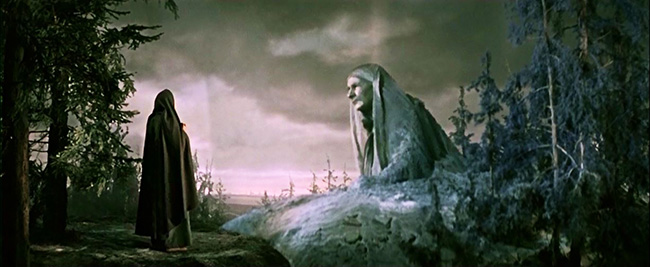
A living mountain speaks.
Further adventures result in the destruction of the Sampo and the wedding of Lemminkäinen and Annikki, but just when the story seems to be resolved, a vengeful Louhi locks the Sun deep inside a mountain and unleashes bitter, endless winter. (Thus, The Day the Earth Froze.) Although the blacksmith suggests that he forge a new sun – because sure, why not? – village elder Väinämöinen (Urho Somersalmi) suggests that instead he forge strings for magical kantele instruments, and that everyone march across the frozen sea and confront the witch with their music. By doing this, they are able to free the Sun, and Lemminkäinen cuts Louhi in two with his sword. Note that throughout this film, every few minutes Ptushko throws another special effect at you, some more subtle than others. Flowers bloom whenever Lemminkäinen and Annikki show their love (to the annoyance of Louhi’s henchmen, who stamp on them). To satisfy Louhi’s demands, Lemminkäinen plows a field full of serpents. In close-ups, Ptushko shows real snakes draped on rocks; for the long shots, he has giant snakes, operated like puppets, lunging at our hero while he drives forth the magical iron horse, glowing red from the fires of its enchanted forge. Reverse photography is used to achieve impossible effects, and optical mattes broaden the scale of Louhi’s island into the far horizon. At one point Ptushko, satisfying the Disney comparisons, sends a bird to alight on Annikki’s hand while she sings.
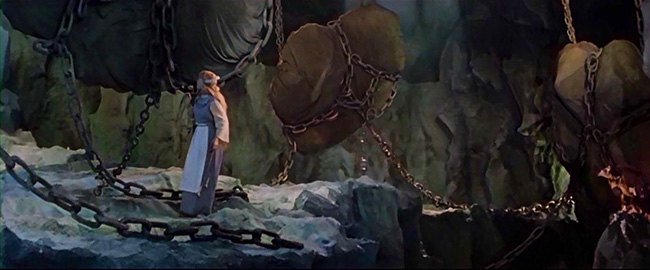
Annikki (Eve Kivi) discovers the weather chained up in Louhi’s mountain.
The 2014 DVD, which contains the Finnish dub with optional English subtitles, provides reproductions of the Cormans’ ad campaign and pressbook for The Day the Earth Froze (released in the U.S. five years after its debut in the Soviet Union and Finland). They’re priceless. Here’s a sample of the pressbook’s suggestions to theaters to help promote the movie:
Popcorn machine to be decorated as a magic mill “Sampo.” Popcorn will be given free to those who bring “Magic Coin.” Magic coins will be distributed by a rider on a motorcycle dressed as one of the characters from the film “The Day the Earth Froze.” … Contest: Everyone who submits five names of the characters from “The Day the Earth Froze” will be eligible to receive a prize.
You mean some poor kids were expected to name five characters from the film? Even the publicity materials only name four, and let’s not forget the hero, as played by “Jon Powers,” is named Lemminkäinen. It was also recommended that The Day the Earth Froze balloons be distributed to patrons. I highly doubt any theater manager took up these optimistic suggestions. (If William Castle were involved and not Roger Corman, it would be a different story.) I wonder what unsuspecting filmgoers thought when they wandered into a matinee? Was anyone leaving a screening in 1964 chanting like the characters gathered round the forge? “Sampo, Sampo, Sampo…”
